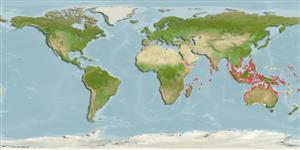>
Beloniformes (Needle fishes) >
Exocoetidae (Flyingfishes)
Etymology: Cheilopogon: Greek, cheilos = lip + Greek, pogon = barbed, beard (Ref. 45335); abei: Named for Prof. Tokiharu Abe, a well known ichthyologist..
Environment: milieu / climate zone / depth range / distribution range
Ecologia
marino; oceanodromo (Ref. 51243); distribuzione batimetrica 0 - 20 m. Tropical; 20°N -
Indo-West Pacific: East Africa to Solomon Islands.
Size / Peso / Age
Maturity: Lm ? range ? - ? cm
Max length : 22.0 cm SL maschio/sesso non determinato; (Ref. 9839)
Raggi dorsali molli (totale): 13-14; Raggi anali molli: 9 - 10; Vertebre: 41 - 43. This species is distinguished by the following characters: have spots on dorsal and ventral fins and yellow cross stripe on pectorals - dorsal fin with a black or gray spot; pelvic fins with a bright black spot; caudal fin lobes uniformly gray
Occurs in neritic surface waters (Ref. 9839).
Life cycle and mating behavior
Maturità | Riproduzione | Deposizione | Uova | Fecundity | Larve
Parin, N.V., 1996. On the species composition of flying fishes (Exocoetidae) in the West-Central part of tropical Pacific. J. Ichthyol. 36(5):357-364. (Ref. 27313)
IUCN Red List Status (Ref. 130435)
Threat to humans
Harmless
Human uses
Pesca: di nessun interesse
Informazioni ulteriori
Nomi ComuniSinonimiMetabolismoPredatoriEcotossicologiaRiproduzioneMaturitàDeposizioneSpawning aggregationFecundityUovaEgg development
BibliografiaAcquacolturaProfilo di acquacolturaVarietàGeneticaElectrophoresesEreditarietàMalattieElaborazioneNutrientsMass conversion
CollaboratoriImmaginiStamps, Coins Misc.SuoniCiguateraVelocitàModalità di nuotoArea branchialeOtolithsCervelliVista
Strumenti
Special reports
Download XML
Fonti Internet
Estimates based on models
Preferred temperature (Ref.
123201): 25.2 - 29.3, mean 28.6 °C (based on 2802 cells).
Phylogenetic diversity index (Ref.
82804): PD
50 = 0.5000 [Uniqueness, from 0.5 = low to 2.0 = high].
Bayesian length-weight: a=0.00646 (0.00292 - 0.01429), b=3.04 (2.84 - 3.24), in cm total length, based on LWR estimates for this (Sub)family-body shape (Ref.
93245).
Trophic level (Ref.
69278): 3.6 ±0.5 se; based on size and trophs of closest relatives
Resilienza (Ref.
120179): Alto, tempo minimo di raddoppiamento della popolazione meno di 15 mesi (Preliminary K or Fecundity.).
Fishing Vulnerability (Ref.
59153): Low vulnerability (17 of 100).
